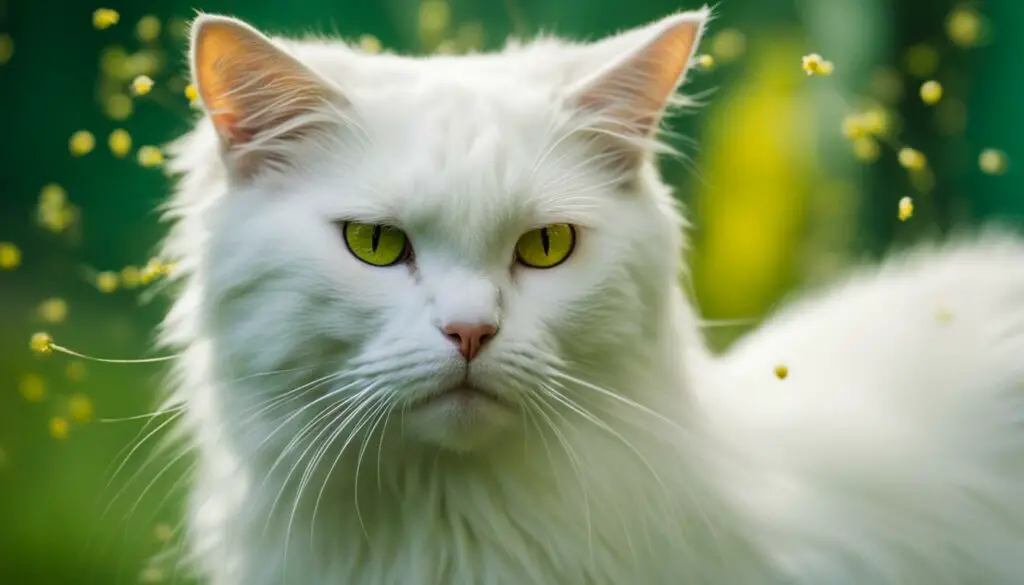Lily pollen can pose serious health risks to cats if ingested or if it comes into contact with their fur. Removing lily pollen from cat fur requires gentle and safe techniques to ensure the well-being of your feline friend. In this article, I will share easy and effective methods to help you remove lily pollen from your cat’s fur, keeping them clean and protected.
Key Takeaways:
- Removing lily pollen from cat fur is essential to protect your cat from potential health risks.
- Cats are particularly susceptible to the dangers of lily pollen, which can cause severe reactions and even kidney failure.
- If you suspect your cat has been exposed to lily pollen, seek veterinary care immediately to prevent further complications.
- Follow a step-by-step guide to safely remove lily pollen from your cat’s fur, using gentle techniques.
- Preventive measures, such as choosing cat-friendly plants and creating an allergy-free zone, can help reduce the risk of cat allergies to lily pollen.
Understanding the Dangers of Lily Pollen for Cats
Lily pollen can be highly toxic to cats if ingested or if it comes into contact with their fur. Cats are particularly susceptible to the dangers of lily pollen, as it can cause severe reactions, including kidney failure. Even a small amount of lily pollen can have devastating effects on a cat’s health. It’s important for cat owners to be aware of the risks and take necessary precautions to prevent their feline friends from being exposed to lily pollen.
Cats can come into contact with lily pollen in various ways. They may brush against lilies in the garden, or the pollen can be transferred to their fur if a bouquet of lilies is brought into the house. When grooming themselves, cats may inadvertently ingest the pollen, leading to potential health issues.
The toxins in lily pollen can cause gastrointestinal problems, including vomiting and diarrhea. Cats may also experience loss of appetite, lethargy, and drooling. However, the most serious consequence of lily pollen ingestion is kidney failure. This can result in increased thirst, frequent urination, dehydration, and ultimately, life-threatening complications.
To protect your cat from the dangers of lily pollen, it’s essential to keep lilies out of their environment. Avoid planting lilies in your garden and opt for cat-friendly plants instead. If you receive a bouquet of flowers, ensure that it does not contain lilies. Regularly inspect your cat’s fur, especially if they have access to outdoor areas where lilies may grow. If you suspect that your cat has come into contact with lily pollen or is showing any symptoms of lily pollen toxicity, it’s crucial to seek veterinary care immediately.
| Dangers of Lily Pollen for Cats | Preventive Measures |
|---|---|
| Kidney failure |
|
| Gastrointestinal problems |
|
| Loss of appetite, lethargy, drooling |
|
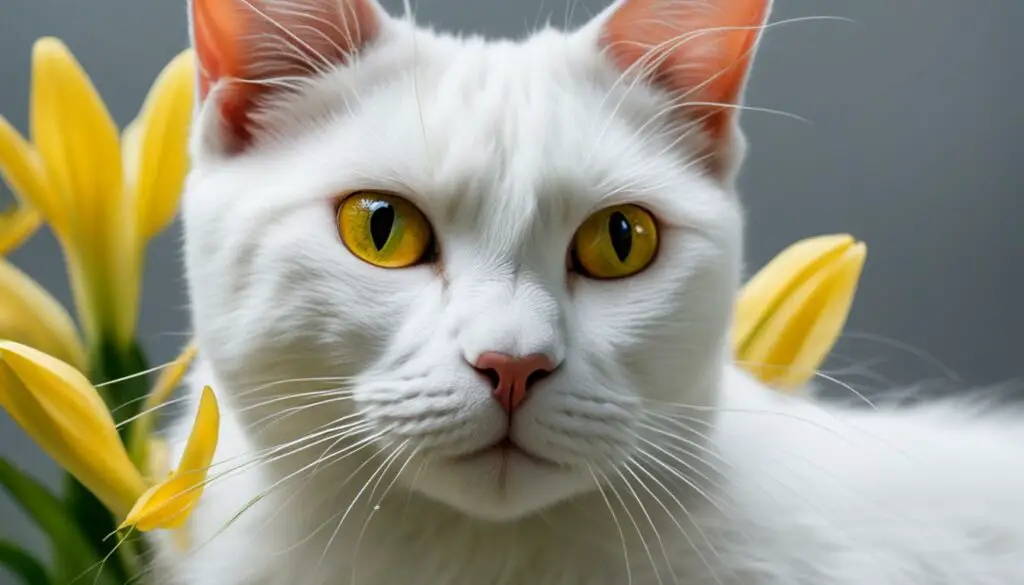
“Even a small amount of lily pollen can have devastating effects on a cat’s health.”
Preventing Lily Pollen Exposure
Prevention is key when it comes to protecting your cat from lily pollen allergies. By being aware of the dangers and taking proactive measures, you can minimize the risk to your feline companion. Here are some additional steps you can take:
- Choose cat-friendly plants for your home and garden.
- Keep your cat’s living areas clean and free from pollen.
- Ensure any floral arrangements or bouquets in your home are free from lilies.
- Regularly groom your cat to remove any pollen that may have settled on their fur.
- Consult with a veterinarian for guidance on allergen avoidance and potential treatment options.
By understanding the dangers of lily pollen and taking preventive measures, you can help ensure the health and well-being of your beloved feline friend.
Signs and Symptoms of Lily Pollen Exposure in Cats
Recognizing the signs and symptoms of lily pollen exposure in cats is crucial for prompt veterinary intervention and ensuring the well-being of your furry friend. Here are some common indicators to watch out for:
- Vomiting: Cats exposed to lily pollen may experience bouts of vomiting as their bodies react to the allergen.
- Loss of appetite: If your cat suddenly loses interest in food, it could be a sign of lily pollen exposure.
- Lethargy: Excessive tiredness or lack of energy can be a symptom of lily pollen allergies in cats.
- Drooling: Cats exposed to lily pollen may exhibit increased drooling or excessive salivation.
In more severe cases of lily pollen exposure, cats can develop kidney failure, leading to more pronounced symptoms such as increased thirst, frequent urination, and dehydration. If you notice any of these signs or suspect that your cat may have come into contact with lily pollen, it is crucial to seek immediate veterinary care to prevent further complications.
Prevention Tips:
To protect your cat from lily pollen exposure and subsequent allergic reactions, it’s essential to take preventive measures. Here are some tips to minimize the risk:
- Avoid bringing lilies into your home or garden if you have a cat.
- Ensure that any floral arrangements or plants in your home are cat-friendly and free from lily pollen.
- Keep your cat indoors, especially during the lily blooming season, to reduce the chances of pollen exposure.
- Regularly clean and vacuum your home to remove any potential pollen particles that may have entered from outside.
- Consult with a veterinarian to determine if your cat requires any specific preventive medications or allergy management strategies.
By staying vigilant, recognizing the signs of lily pollen exposure, and taking preventive measures, you can help protect your cat from the health risks associated with lily pollen.
| Signs and Symptoms | Prevention Tips |
|---|---|
| Vomiting | Avoid bringing lilies into your home or garden if you have a cat. |
| Loss of appetite | Ensure that any floral arrangements or plants in your home are cat-friendly and free from lily pollen. |
| Lethargy | Keep your cat indoors, especially during the lily blooming season, to reduce the chances of pollen exposure. |
| Drooling | Regularly clean and vacuum your home to remove any potential pollen particles that may have entered from outside. |
| Kidney failure | Consult with a veterinarian to determine if your cat requires any specific preventive medications or allergy management strategies. |
Remember, the well-being of your cat should always be a priority, and taking proactive steps to prevent lily pollen exposure can help ensure their continued health and happiness.
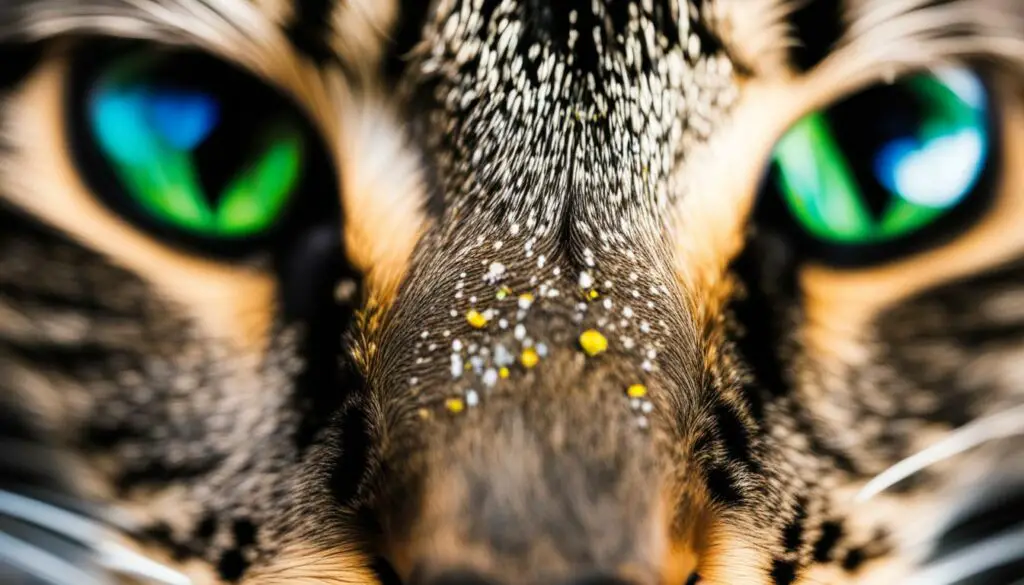
Removing Lily Pollen from Cat Fur – Step by Step Guide
Removing lily pollen from cat fur requires a gentle and careful approach. Here’s a step-by-step guide to help you effectively remove lily pollen from your cat’s fur:
1. Assess the Situation
Before starting the removal process, carefully examine your cat’s fur to determine the extent of lily pollen contamination. Look for visible yellow stains or particles on the fur. This will help you decide the best course of action.
2. Use a Damp Cloth or Paper Towel
Moisten a clean cloth or paper towel with warm water and gently wipe the affected areas of your cat’s fur. Be sure to avoid rubbing vigorously, as this may spread the pollen or irritate your cat’s skin. Pat the fur dry with a clean towel afterward.
3. Try a Pet-Safe Shampoo
If the lily pollen stains are stubborn or if your cat’s fur is heavily contaminated, you can use a pet-safe shampoo specifically designed for cats. Dilute the shampoo according to the instructions and carefully lather it onto the affected areas. Rinse thoroughly and dry your cat’s fur completely.
4. Consult a Veterinarian if Necessary
If you’re unsure about the proper removal techniques or if your cat shows any signs of discomfort after the pollen removal process, it’s essential to seek advice from a veterinarian. They can provide further guidance and ensure the well-being of your cat.
By following these step-by-step instructions, you can safely and effectively remove lily pollen from your cat’s fur, reducing the risk of allergies and health issues. Keep in mind that prevention is key, so it’s important to keep lilies and other toxic plants out of your cat’s environment.
| Step | Description |
|---|---|
| 1 | Assess the Situation |
| 2 | Use a Damp Cloth or Paper Towel |
| 3 | Try a Pet-Safe Shampoo |
| 4 | Consult a Veterinarian if Necessary |
Preventing Cat Allergies to Lily Pollen
If you want to protect your cat from the harmful effects of lily pollen and prevent cat allergies, there are several measures you can take. By implementing these preventive strategies, you can create a safe and allergy-free environment for your feline friend:
- Avoid bringing lilies into your home or garden, as they are highly toxic to cats.
- Choose cat-friendly plants that are non-toxic and do not produce allergenic pollen.
- Create an allergy-free zone for your cat by keeping them away from areas where lilies or other allergenic plants are present.
- Regularly clean your home to minimize the presence of pollen and other allergens.
- Consult a veterinarian for allergy testing if you suspect that your cat is allergic to lily pollen or other allergens.
By following these preventive measures, you can significantly reduce the risk of cat allergies to lily pollen and ensure the well-being of your beloved pet.

Remember, prevention is key when it comes to protecting your cat from lily pollen and other allergens. It’s important to be vigilant and take proactive steps to keep your feline friend safe and healthy. If you have any concerns or questions about lily pollen allergies in cats, don’t hesitate to reach out to your veterinarian for guidance and support. Your cat’s health is worth it!
Importance of Prompt Veterinary Care
When it comes to the health and well-being of our beloved feline companions, prompt veterinary care is of utmost importance. This is especially true when dealing with the potential health risks of lily pollen on cats. If you suspect that your cat has been exposed to lily pollen or is exhibiting any signs of lily pollen toxicity, it is crucial to seek veterinary attention as soon as possible.
Veterinarians are trained professionals who can assess your cat’s condition, provide appropriate treatment, and offer guidance on how to manage and prevent future exposure to lily pollen. They have the expertise and resources to accurately diagnose any potential health issues and implement the necessary interventions.
Remember, early intervention is key when it comes to mitigating the risks associated with lily pollen on cats. By seeking prompt veterinary care, you can help prevent further complications and ensure the best possible outcome for your furry friend’s health.
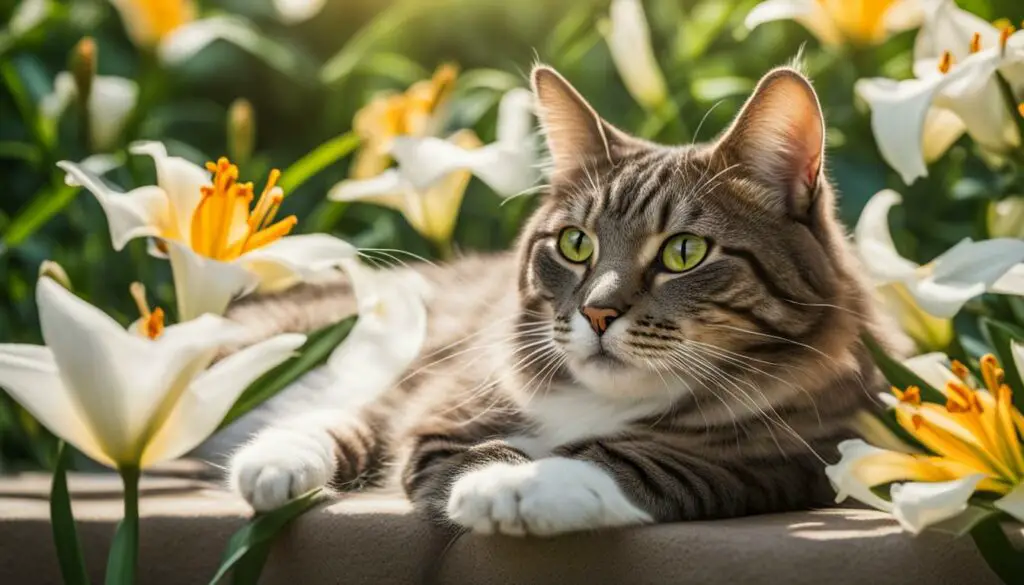
As responsible pet owners, it is our duty to prioritize the well-being of our cats. By being proactive and seeking professional help when needed, we can safeguard their health and provide them with the care they deserve.
Safe Home Remedies for Lily Pollen Removal
When it comes to removing lily pollen from your cat’s fur, there are some safe home remedies you can try. These remedies are gentle and effective, ensuring that your feline friend remains clean and free from any potential health risks.
1. Damp Cloth: One simple method is to use a damp cloth to gently wipe away the lily pollen from your cat’s fur. Make sure the cloth is slightly damp, not wet, to prevent overexposure to moisture.
2. Cornstarch: Another option is to sprinkle cornstarch onto the affected areas of your cat’s fur. Gently massage the cornstarch into the fur, allowing it to absorb the pollen. Then, brush off the excess cornstarch using a soft brush or comb.
3. Baby Wipes: Baby wipes can also be used to remove lily pollen from your cat’s fur. Look for fragrance-free, hypoallergenic wipes to minimize the risk of any allergic reactions. Gently wipe the affected areas, making sure to avoid the eyes and mouth.
Remember, always consult with a veterinarian if you’re unsure about using any home remedies or if your cat is showing signs of lily pollen exposure. A professional opinion will ensure the safety and well-being of your furry companion.
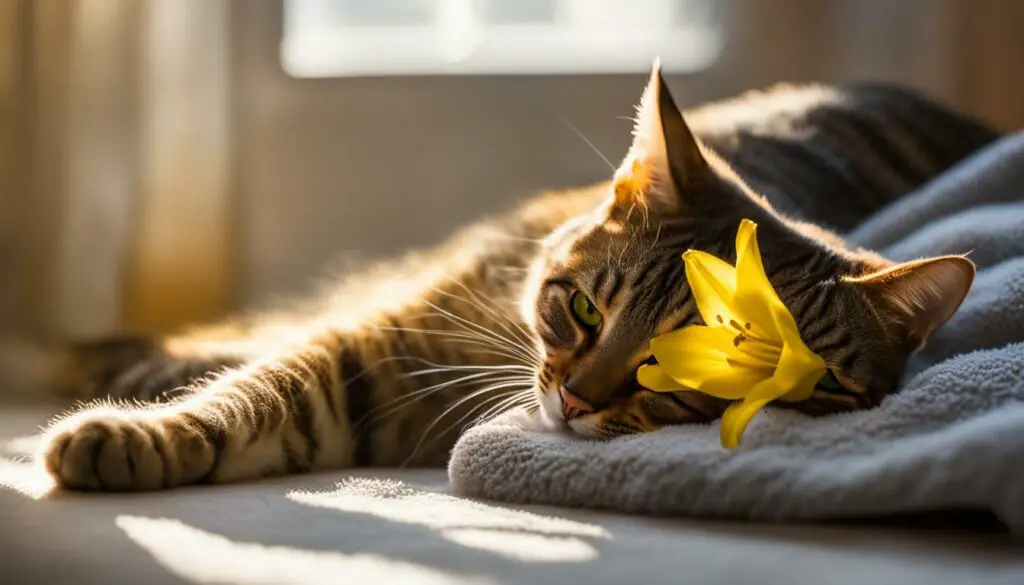
Table: Comparison of Safe Home Remedies for Lily Pollen Removal
| Home Remedies | Effectiveness | Gentle on Cat’s Fur | Ease of Use |
|---|---|---|---|
| Damp Cloth | ✓ | ✓ | ✓ |
| Cornstarch | ✓✓ | ✓ | ✓ |
| Baby Wipes | ✓✓ | ✓ | ✓ |
“Using safe home remedies like a damp cloth, cornstarch, or baby wipes can effectively remove lily pollen from your cat’s fur, ensuring their cleanliness and well-being.” – Dr. Emily Thompson, DVM
By utilizing these safe and simple home remedies, you can effectively remove lily pollen from your cat’s fur without causing any harm or discomfort. Remember to be gentle and patient during the process, ensuring that your cat feels safe and comfortable. Regularly monitor your cat for any signs of lily pollen exposure and consult with a veterinarian if you have any concerns.
Importance of Preventive Measures for Lily Pollen Safety
Ensuring the safety of our beloved feline friends is of utmost importance, especially when it comes to potential allergens like lily pollen. By implementing preventive measures, we can protect our cats from the risks associated with lily pollen exposure and ensure their well-being.
Pollen-Free Zone
Creating a pollen-free zone within our homes can significantly reduce the risk of our cats coming into contact with lily pollen. Designate a specific area where your cat can play and relax without the presence of any potentially harmful pollen. This can be achieved by keeping lilies and other pollen-producing plants out of this designated space.
Cat-Friendly Plants
Choosing cat-friendly plants is another essential preventive measure. Opt for non-toxic plants that do not produce allergenic pollen, such as spider plants, Boston ferns, or orchids. These plants not only provide a safe environment for your cat but also add beauty and freshness to your home.
Regular Cleaning
Regularly cleaning your home, especially areas where your cat spends a lot of time, can help remove any traces of lily pollen and minimize the risk of exposure. Vacuuming carpets, dusting surfaces, and washing bedding at least once a week can significantly reduce the presence of allergens in your home.
Veterinary Guidance
Consulting with a veterinarian is vital in implementing effective preventive measures. A veterinarian can provide expert advice tailored to your cat’s specific needs, recommend appropriate allergen avoidance strategies, and offer guidance on how to best protect your cat from the risks of lily pollen.
Education and Awareness
Spreading awareness about the dangers of lily pollen is crucial in ensuring the safety of not only our own cats but also cats in our communities. Share information about lily pollen on social media, educate friends and family, and advocate for the use of cat-friendly plants to create a safer environment for all feline companions.
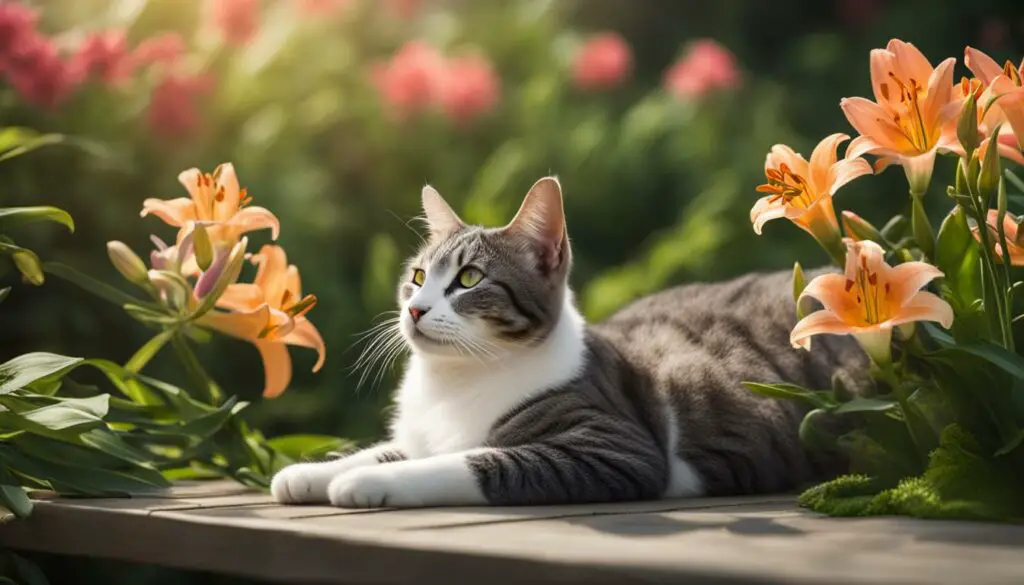
By implementing these preventive measures, we can minimize the risk of cat allergies to lily pollen and ensure a safe and healthy environment for our furry friends. Remember, prevention is key, and by taking proactive steps, we can keep our cats happy and protected from potential allergens like lily pollen.
Seeking Professional Help
If you’re unsure about how to safely remove lily pollen from your cat’s fur or if your cat has ingested lily pollen, it’s crucial to seek professional help from a veterinarian. They can provide expert guidance, assess the situation, and recommend appropriate treatment options based on your cat’s specific needs. Remember, the health and well-being of your feline friend should always be a priority, and professional advice can help ensure the best possible outcome.
When it comes to lily pollen and the potential health risks it poses to cats, it’s always better to err on the side of caution. Veterinarians are trained to handle these situations and can provide the necessary care and support your cat needs. They may conduct a thorough examination to determine if your cat has come into contact with lily pollen and assess any potential health effects.
If your cat has ingested lily pollen, your veterinarian may recommend inducing vomiting, administering activated charcoal, or other appropriate treatments to minimize the absorption of toxins. They will also closely monitor your cat’s renal function and provide supportive care as needed.
By seeking professional help, you can ensure that your cat receives the best possible care and treatment when it comes to lily pollen exposure. Remember, even small amounts of lily pollen can have serious consequences for your cat’s health, so don’t hesitate to reach out to a veterinarian for assistance.
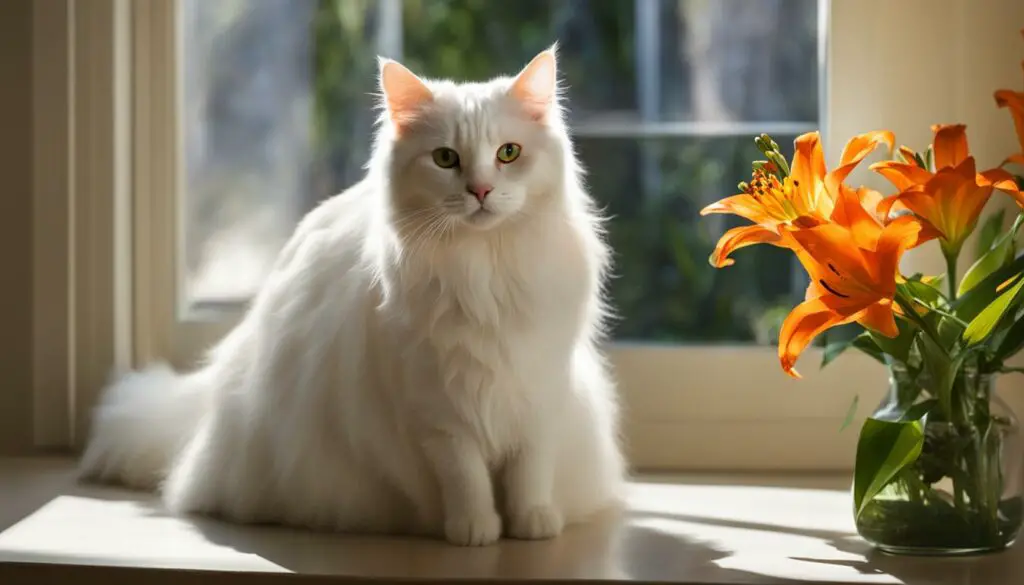
Why professional help is important:
- Expert guidance and advice on safely removing lily pollen from your cat’s fur
- Assessment of your cat’s health and potential risks associated with lily pollen exposure
- Appropriate treatment options tailored to your cat’s specific needs
- Monitoring of renal function and provision of supportive care if necessary
Remember, the health and well-being of your cat should always be a priority. Seeking professional help is the best way to ensure that your cat receives the care and treatment they need when it comes to lily pollen exposure. Don’t hesitate to reach out to a veterinarian for assistance.
Importance of Cat-Friendly Plants
When it comes to creating a safe and healthy environment for your cat, choosing cat-friendly plants is of utmost importance. By opting for plants that are non-toxic and do not produce allergenic pollen, you can prevent potential health risks and allergies in cats. It is essential to prioritize the well-being of our feline companions and ensure their safety.
Cat-friendly plants offer numerous benefits, ranging from providing environmental enrichment to improving air quality. These plants not only beautify your home or garden but also create a safe space where your cat can explore and play without the risk of pollen-related health issues. By selecting the right plants, you can create a harmonious and healthy environment for both you and your cat.
| Plant | Benefits |
|---|---|
| Spider Plant | The spider plant is non-toxic to cats and can help improve indoor air quality by absorbing harmful pollutants. |
| Boston Fern | Boston ferns are safe for cats and can add a touch of greenery to your living space. They also help humidify the air. |
| Orchids | Orchids are non-toxic to cats and provide a beautiful and elegant addition to any room. |
When selecting cat-friendly plants, it’s important to consult with a veterinarian or do thorough research to ensure the suitability of the plants for your cat’s environment. Remember to avoid plants that are known to be toxic to cats, such as lilies, as they can pose serious health risks if ingested or if their pollen comes into contact with your cat’s fur.
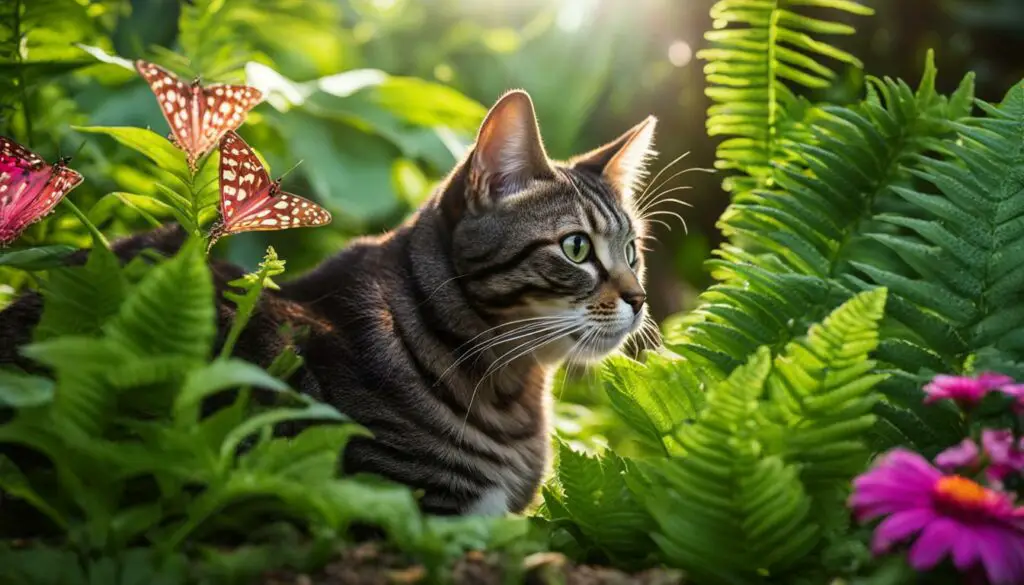
Creating a Cat-Friendly Environment
In addition to incorporating cat-friendly plants, you can further enhance your cat’s environment by providing enriching toys, scratching posts, and comfortable resting areas. Creating vertical spaces, such as cat trees or shelves, can also give your cat opportunities for climbing and exploring.
Remember to regularly inspect your cat’s environment for any potential hazards or toxic substances. Keep cleaning products, medications, and household chemicals securely stored in areas that are inaccessible to your cat. By taking preventive measures and creating a cat-friendly environment, you can ensure the safety and well-being of your feline companion.
Creating an Allergy-Free Zone for Your Cat
Preventing cat allergies to lily pollen is essential for ensuring the health and well-being of your feline companion. By creating an allergy-free zone in your home, you can minimize the risk of your cat being exposed to lily pollen and experiencing allergic reactions. Here are some tips to help you create an allergy-free zone:
- Keep lily plants out of your home: Avoid bringing lily plants into your living space, as they can release pollen that may settle on your cat’s fur.
- Designate a pollen-free area: Set aside a specific area in your home where your cat can relax and play without the risk of pollen exposure. Consider using an air purifier in this area to filter out any airborne pollen particles.
- Regular cleaning: Vacuum and dust your home frequently to remove any pollen particles that may have entered your living space. Pay close attention to areas where pollen can accumulate, such as windowsills and furniture.
- Wash bedding and fabrics: Launder your cat’s bedding, blankets, and any other fabrics that may come into contact with pollen regularly. Use a hypoallergenic detergent to ensure thorough cleaning.
Importance of an Allergy-Free Zone
An allergy-free zone provides your cat with a safe and protected environment where they can thrive without the risk of allergic reactions. It allows them to enjoy their surroundings without discomfort, ensuring a happy and healthy life. By implementing these measures, you can create a space that is free from the dangers of lily pollen and other allergens.
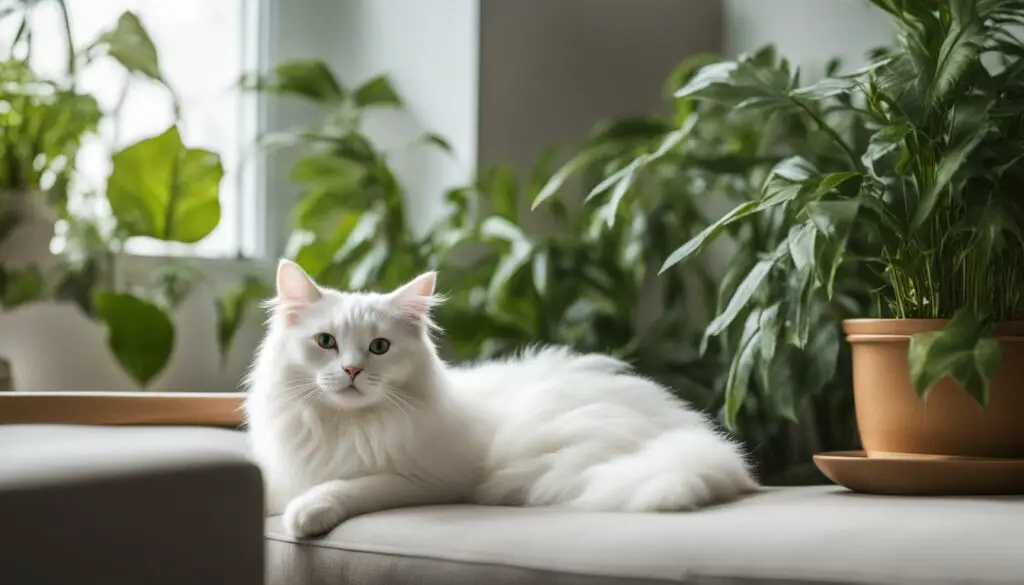
Summary
Preventing cat allergies to lily pollen is crucial for maintaining your cat’s health and well-being. By creating an allergy-free zone in your home, you can minimize the risk of allergic reactions and provide a safe environment for your feline companion. Remember to keep lily plants out of your home, designate a pollen-free area, regularly clean your living space, and wash bedding and fabrics to remove any pollen particles. By taking these steps, you can ensure that your cat remains allergy-free and happy.
Consulting a Veterinarian for Allergies and Allergy Testing
If you suspect that your cat is allergic to lily pollen or other allergens, it’s important to consult a veterinarian for proper diagnosis and allergy testing. A veterinarian can perform tests to identify specific allergens and develop a personalized treatment plan for your cat. This may include allergen avoidance strategies, medication, or immunotherapy to manage your cat’s allergies effectively.
Allergy testing is crucial in determining the root cause of your cat’s allergic reactions and providing targeted treatment. Through blood tests or skin tests, your veterinarian can identify the specific allergens triggering your cat’s allergies, including lily pollen. This information is valuable in developing a customized treatment plan that addresses your cat’s specific needs.
During the consultation, it is important to provide your veterinarian with detailed information about your cat’s symptoms, exposure to lily pollen, and any previous allergic reactions. This will help the veterinarian make an accurate diagnosis and determine the most appropriate course of action for your cat’s well-being.
Remember, while there may be home remedies and preventive measures you can take to manage your cat’s allergies, consulting a veterinarian is crucial for proper diagnosis and treatment. Your veterinarian has the expertise and knowledge to guide you through the process and ensure the best possible outcome for your cat’s health.
| Allergies & Testing: | Veterinary Consultation |
|---|---|
| Benefits | Proper diagnosis and treatment planning |
| Testing Options | Blood tests or skin tests |
| Customized Treatment | Allergen avoidance, medication, or immunotherapy |
| Expert Guidance | Veterinarian’s expertise and knowledge |
Removing Lily Pollen from Cat Fur – Step by Step Guide
In order to effectively remove lily pollen from your cat’s fur, it’s important to follow a gentle and careful approach. Here’s a step-by-step guide to help you safely remove lily pollen from your feline friend:
- First, gather the necessary supplies. You will need a clean cloth or sponge, lukewarm water, and a mild pet shampoo.
- Dampen the cloth or sponge with lukewarm water, making sure it’s not too hot or too cold for your cat’s comfort.
- Gently wipe the affected areas of your cat’s fur using the damp cloth or sponge. Be careful not to rub or scrub too vigorously, as this may cause discomfort or skin irritation.
- If the lily pollen stains are stubborn and don’t come off with water alone, you can mix a small amount of mild pet shampoo with the water to create a gentle cleaning solution. Again, apply the solution with the damp cloth or sponge and gently wipe the affected areas.
- Rinse the cloth or sponge thoroughly to remove any residual shampoo and continue to wipe the affected areas to ensure all lily pollen is removed.
- After the pollen has been removed, pat your cat’s fur dry with a clean towel. Make sure to dry the fur thoroughly to prevent any moisture from causing skin issues.
Remember, always approach the process with care and gentleness to ensure your cat’s comfort and well-being. If you encounter any difficulties or your cat experiences any discomfort during the pollen removal process, it’s best to consult with a veterinarian for further assistance.
Table: Recommended Methods for Lily Pollen Removal
| Method | Description |
|---|---|
| Using a damp cloth or sponge | Gently wiping the affected areas of the cat’s fur with lukewarm water to remove lily pollen. |
| Mixing mild pet shampoo with water | Creating a gentle cleaning solution to remove stubborn lily pollen stains from the cat’s fur. |
| Drying with a clean towel | Patting the cat’s fur dry with a towel after the pollen has been removed to prevent moisture-related issues. |
By following these step-by-step instructions and using the recommended methods, you can effectively remove lily pollen from your cat’s fur and help prevent any potential allergies or health risks.
Understanding the Importance of Lily Pollen Awareness
In order to protect our beloved feline companions from the potential dangers of lily pollen, it is crucial to raise awareness about this issue. By educating ourselves and others about the risks associated with lily pollen, we can create a safer environment for our pets and prevent unnecessary harm.
Spreading information about lily pollen safety on social media platforms, such as Facebook and Twitter, can reach a wide audience and help raise awareness. By sharing posts and articles that highlight the dangers of lily pollen and promote pet safety, we can ensure that this vital information reaches as many people as possible.
“Increasing awareness about the dangers of lily pollen is key in preventing potential harm to cats.”
Additionally, we can play an active role in educating our friends and family members about the risks associated with lily pollen. By having open and honest conversations and sharing our knowledge, we can empower others to make informed decisions and take necessary precautions to keep their own pets safe.
Advocating for the use of cat-friendly plants is another important step in promoting lily pollen awareness. By encouraging the adoption of non-toxic plants that do not produce allergenic pollen, we can minimize the risk of exposure for cats and reduce the likelihood of allergic reactions or other health issues.
Table: Lily Pollen Awareness Tips
| Tips to Raise Awareness |
|---|
| Share information on social media |
| Educate friends and family |
| Promote cat-friendly plants |
By working together and taking these proactive steps, we can make a difference in the lives of our furry friends. Lily pollen awareness is essential in ensuring the safety and well-being of cats, and by taking action, we can create a world where they are protected from this potential threat.
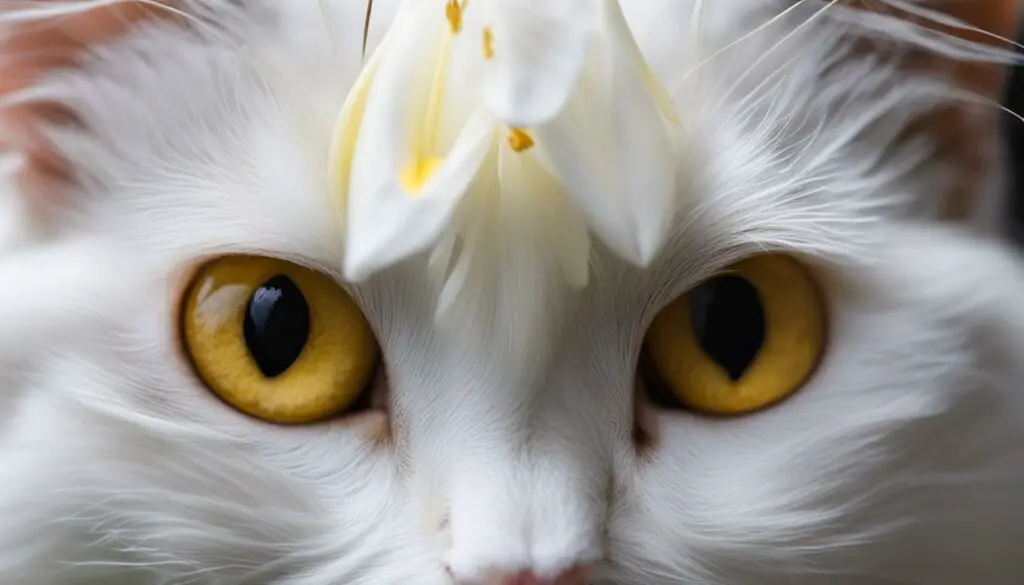
Conclusion
In conclusion, it is crucial for cat owners to be aware of the health risks associated with lily pollen on cat fur. Lily pollen can be highly toxic to cats and can lead to severe reactions, including kidney failure. Therefore, it is important to take necessary precautions and remove lily pollen from your cat’s fur to ensure their well-being.
By following the step-by-step guide provided in this article, you can safely and effectively remove lily pollen from your cat’s fur. Additionally, creating an allergy-free zone for your cat and choosing cat-friendly plants can help prevent cat allergies to lily pollen.
Remember, if you suspect that your cat has been exposed to lily pollen or is showing any signs of lily pollen toxicity, seek prompt veterinary care. A veterinarian can provide expert guidance and recommend appropriate treatment options based on your cat’s specific needs.
Increasing awareness about the dangers of lily pollen is also crucial in preventing harm to cats. By sharing information and advocating for cat-friendly plant options, we can create a safer environment for our feline companions. Together, let’s protect our cats from the health risks of lily pollen and ensure their overall well-being.
FAQ
Can lily pollen be harmful to cats?
Yes, lily pollen can be highly toxic to cats if ingested or if it comes into contact with their fur.
What are the signs and symptoms of lily pollen exposure in cats?
Some common symptoms include vomiting, loss of appetite, lethargy, drooling, and in severe cases, kidney failure.
How can I remove lily pollen from my cat’s fur?
To remove lily pollen from your cat’s fur, you can try gentle wiping with a damp cloth or using pet-friendly wet wipes.
How can I prevent cat allergies to lily pollen?
Some preventive measures include keeping lilies out of your cat’s reach, creating an allergy-free zone, and opting for cat-friendly plants.
When should I seek veterinary care for lily pollen exposure?
It is crucial to seek veterinary care immediately if you suspect your cat has been exposed to lily pollen or is showing any signs of toxicity.
Are there any home remedies to remove lily pollen from cat fur?
Yes, you can try using a pet-friendly shampoo or using a mixture of water and baking soda to gently wash your cat’s fur.
How can I ensure lily pollen safety for my cat?
You can ensure lily pollen safety for your cat by keeping lilies out of your home, regularly cleaning your cat’s environment, and consulting a veterinarian for guidance.
What should I do if I’m unsure how to remove lily pollen from my cat’s fur?
If you’re unsure, it’s best to seek professional help from a veterinarian who can provide expert guidance and recommend appropriate treatment options.
Are there any cat-friendly plants I can choose instead of lilies?
Yes, some cat-friendly plants include spider plants, Boston ferns, and orchids. Consult with a veterinarian or do research to select the most suitable plants.
How can I create an allergy-free zone for my cat?
You can create an allergy-free zone by keeping lilies and other allergens out of that area, using air purifiers, and regularly cleaning the space to minimize allergen exposure.
When should I consult a veterinarian for cat allergies to lily pollen?
It’s important to consult a veterinarian for proper diagnosis and allergy testing if you suspect your cat is allergic to lily pollen or other allergens.
Why is pollen removal important for cat allergy management?
Regular removal of pollen from your cat’s fur can minimize the risk of allergen exposure and alleviate allergic reactions.
How can we raise awareness about the dangers of lily pollen?
We can raise awareness by sharing information on social media, educating friends and family, and advocating for the use of cat-friendly plants.

